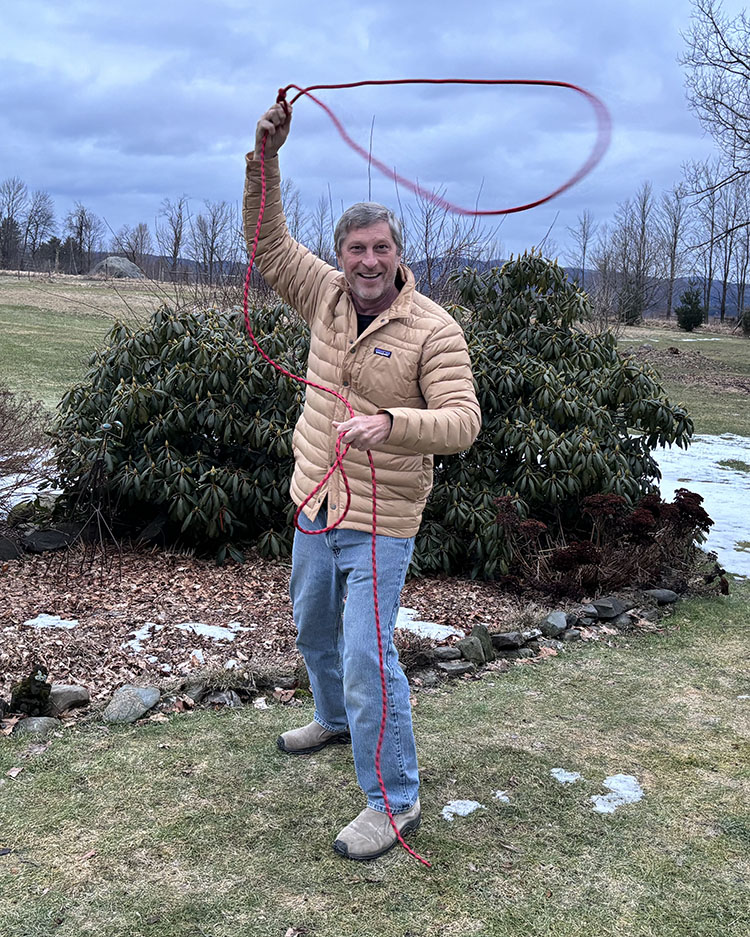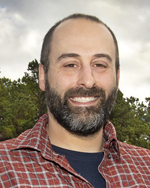Giangrande Replaces Vogelmann as Co-Lead of ARM Modeling Activity
Published: 15 February 2024
Change on LASSO team also means change within ARM’s science translator group

There has been a leadership change within the Atmospheric Radiation Measurement (ARM) user facility’s signature modeling activity.
Scott Giangrande, a meteorologist at Brookhaven National Laboratory in New York, is the new co-principal investigator of the Large-Eddy Simulation (LES) ARM Symbiotic Simulation and Observation (LASSO) activity. He succeeds Andrew Vogelmann, who recently retired from Brookhaven Lab after 20 years there as an atmospheric scientist.
Giangrande now co-leads the LASSO activity with William Gustafson, an earth scientist at Pacific Northwest National Laboratory in Washington state.
Giangrande’s move to the LASSO team created an opening within ARM’s science translator group. Filling that role is Dié Wang, a cloud process scientist at Brookhaven Lab.
Vogelmann, a LASSO Pioneer
Vogelmann and Gustafson worked on LASSO together since it began as a pilot project in 2015.
To provide a more complete look at the atmosphere around ARM sites, LASSO combines real-world observations with high-resolution model simulations. It also delivers evaluation diagnostics and model skill scores so users can see how well the simulations agree with the observations.
LASSO initially focused on shallow convection around ARM’s Southern Great Plains (SGP) atmospheric observatory in Oklahoma before expanding to other sites and atmospheric phenomena.
In 2022, the LASSO team began to release simulations of deep convection observed by ARM during the 2018–2019 Cloud, Aerosol, and Complex Terrain Interactions (CACTI) field campaign in Argentina.
Before retiring, Vogelmann helped with planning an upcoming LASSO maritime cloud scenario for ARM’s Eastern North Atlantic (ENA) observatory in the Azores.
“I have really enjoyed working with Andy over the last eight-plus years on LASSO,” says Gustafson. “Our specialties complemented each other’s really well to make LASSO a useful and powerful data set for the community that will last way beyond our two tenures. Andy’s fingerprints on LASSO include his targeted approach of using skill scores in combination with our simulations and his insights into the different ARM observations and value-added products that have helped link LASSO simulations to ARM’s greater effort.”
Vogelmann’s departure will be felt in other ways.
“The LASSO team will miss Andy’s thoughtful questions and banter in our team telecons,” says Gustafson. “I wish him well in his next ventures.”
Reflections on a Fruitful ARM History

Vogelmann started using ARM data in 1995 as a postdoctoral researcher in Veerabhadran Ramanathan’s group at Scripps Institution of Oceanography at the University of California San Diego. He then ramped up his ARM participation in the 2000s. During various parts of the decade, he was on the steering committee for ARM’s Radiative Processes Working Group (2000–2009), co-chaired the Clouds with Low Optical Water Depths (CLOWD) Working Group (2004–2009), and served as ARM’s associate chief scientist (2005–2009).
In the first half of 2009, Vogelmann was the lead scientist for the Routine ARM Aerial Facility CLOWD Optical Radiative Observations (RACORO) campaign at the SGP. RACORO, he says, was “a first-of-a-kind, extended-term aircraft experiment to obtain in situ cloud property statistics of boundary-layer clouds, guided by a brilliant steering committee (Greg McFarquhar, John Ogren, Dave Turner, Jennifer Comstock, Graham Feingold, and Chuck Long)—you know, standing on the shoulders of giants and all.”
During his career, Vogelmann authored 51 ARM-supported journal articles. His most recent ARM-related paper came out in December 2023. Co-authors on that paper included Gustafson and lead author Damao Zhang, a former postdoc of Vogelmann’s at Brookhaven Lab. Zhang is now an earth scientist and ARM translator at Pacific Northwest National Laboratory.
While Vogelmann looks forward to enjoying his retirement in Vermont, he says he will miss “the camaraderie of my dedicated colleagues and friends who work in the different spheres of the ARM ecosystem.”
ARM thanks Vogelmann for his valuable contributions over the years and wishes him the best in his next chapter.
Translator Transition

The LASSO team is excited to welcome Giangrande as the activity’s new co-principal investigator.
From 2016 to 2024, Giangrande served as an ARM translator. During his tenure, he guided the development of several cloud and precipitation science products, including Laser and Video Disdrometer Quantities (LDQUANTS and VDISQUANTS).
As ARM’s lead translator from 2021 to 2023, Giangrande coordinated the development of value-added products across all of the user facility’s science focus areas. He also oversaw yearly planning for translator priorities and activities related to ARM’s three-year translator vision plan.
“Scott’s expertise with clouds and radars, and his knowledge of the wide array of ARM products, learned during his prior role as lead translator, will be of great benefit for LASSO,” says Gustafson. “He is already jumping in and helping us pick the case dates for the new LASSO-ENA scenario, currently under development.”

Meanwhile, Wang will bring her own extensive ARM experience to the translator group. She is the lead instrument mentor for ARM disdrometers, rain gauges, and most of its weighing bucket precipitation gauges.
Wang is also an active ARM data user. For the past year, she has been a co-investigator for ARM’s Eastern Pacific Cloud Aerosol Precipitation Experiment (EPCAPE) in La Jolla, California. At the same time, she has been working on a five-year project funded through the U.S. Department of Energy (DOE) Early Career Research Program to better understand the effect of atmospheric particles on deep convective cloud systems.
In 2023, Wang became a co-chair of the Convective Processes Working Group within DOE’s Atmospheric System Research (ASR) program. She represents the working group on the ARM-ASR Coordination Team, which helps plan the Joint ARM User Facility/ASR Principal Investigators Meeting.
As an ARM translator, Wang will manage the value-added products previously overseen by Giangrande while working to develop new products for the scientific community.
Keep up with the Atmospheric Observer
Updates on ARM news, events, and opportunities delivered to your inbox
ARM User Profile
ARM welcomes users from all institutions and nations. A free ARM user account is needed to access ARM data.


















